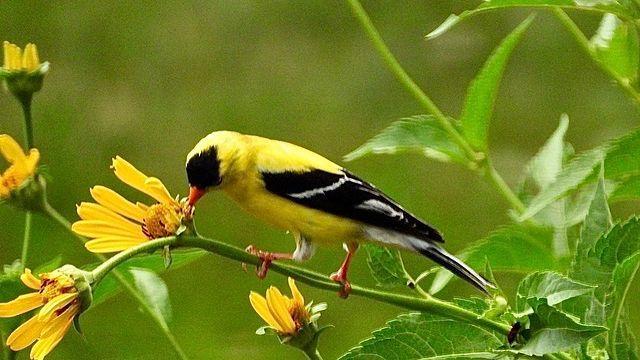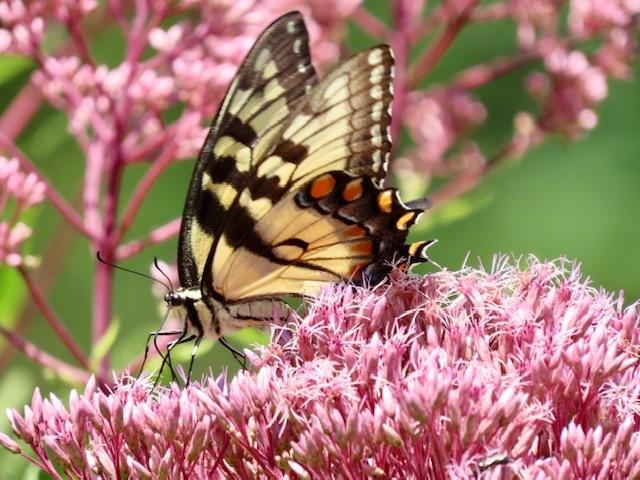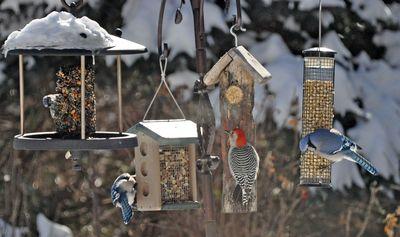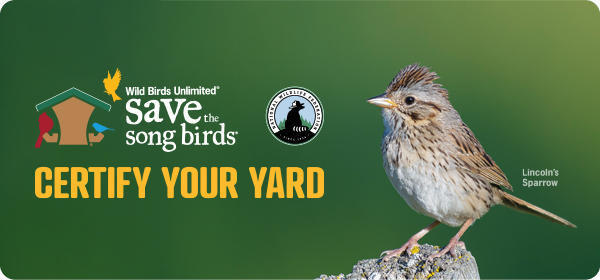Gardening for Wildlife
Native Gardening for Birds and Other Wildlife - Certify Your Yard!!
The North American bird population has decreased by 2.9 billion breeding adults, a net loss of 29% over the last half-century.* Scientists have identified habitat loss as the biggest reason for the decline. Wild Birds Unlimited is proud to be the new Champion for the National Wildlife Federation Certified Wildlife Habitat program, whose goal is to inspire everyone to create a haven for wildlife in their yard. WBU of Syosset has been advocating for backyard habitats since our opening. Read on for more information and some tips.
As habitat decreases, pocket (backyard) habitats become critical links needed to create contiguous habitat corridors for wildlife. You can can become a backyard conservationist and help out birds, bees, butterflies and other critters by planting native trees, shrubs, and other plants that provide food, protection from predators, resting spots during migration, and nesting spots during breeding season. Resources are at end of article.
Why Natives?
Up to NINE THOUSAND caterpillars are needed to feed just one clutch of chickadees during nesting season. Yes, you read that correctly…nine thousand and one clutch. Imagine several families raising young in your yard, several in the yard over and so on. Now, think about even larger birds and the numbers become staggering.
Speaking of numbers, look at these: 550 versus 4. Native oak trees host over 550 species of caterpillars, while nonnative Callary pears host about four. A native dogwood hosts over 100 species, while the popular Asian ornamental kousa dogwood supports virtually nothing.
Native plants are critical because they support native insects, most of which are specialists rather than generalists and will not feed on non-natives. Insects are a critical food source for a variety of birds and other animals, particularly those raising young. In fact, almost all land birds require insects to feed their young. Even seed and nectar eating birds must feed their babies insects to ensure their survival.
It doesn’t take a mathematician to figure out that the native trees are going to help feed those hungry chickadee nestlings while the nonnatives will do barely anything to assist in their survival. Birds also depend on berries and seeds of shrubs, grasses, and flowers in the fall and winter
It doesn't just affect baby birds. One 6-year study in Ohio determined that Northern cardinals paid a steep price when nesting in areas thick with honeysuckle: these birds reared 20% less young than did cardinals nesting in native plants. In addition, according to these studies, birds that ate the berries from these plants were artificially bright, signifying to females that they were good choices for mates. Normally male cardinals with a deeper red color are more fit because they are feeding on nutrient rich berries that contain carotenoid pigments. Honeysuckle berries contain lots of carotenoid pigments but are nutrient poor. Coloration becomes meaningless as a sign of quality in a mate with the results being that females are mistakenly choosing less fit males as mates. This can lead to population declines as less sturdy genes are passed on from generation to generation.
Fewer insects and natives means fewer birds!
In addition, butterflies, bees, hummingbirds and moths depend on native plants for their rich nectar and pollen. While going about their daily business, pollinators transfer pollen between flowers of the same species. These pollinated plants will then produce fertile seed. Pollinators are critical to our food supply and are responsible for the pollination of the vast majority of all flowering plants. Foods and beverages produced with the help of pollinators include: apples, blueberries, chocolate, coffee, melons, peaches, potatoes, pumpkins, vanilla, almonds and tequila (thank a bat for that one if you are a fan of margaritas!). Over 150 food crops in the US depend on pollinators!
What's in it For Me?
Homeowners who choose native plants spend less time, energy, and money to maintain their landscaping because once established, native plants require less care. They are adapted to the local climate and soil conditions. Native plants work well for landscaping, and once established they rarely need watering or mowing. Less time working on the garden means more time relaxing and enjoying it!
Tips For Creating Your Own Backyard Habitat

Choose plants that bloom from early spring to late fall, with at least three species that bloom each season. This provides food throughout the growing season.
Provide both “host” and “nectar” plants. Monarch butterflies are especially vulnerable due to problems in their wintering grounds as well as a decrease in milkweed and other host plants. Help monarchs by planting milkweed in your garden and fields.
Plant with diversity in mind. Different flower shapes, colors, sizes and heights. Plant species in bunches, rather than singly, which makes it easier for pollinators to locate them.
Plant in layers. Think from the tree canopies down to the ground. Map out your yard to make sure that what you have in mind will work.
Before choosing your plants, make sure they are suitable for the sun, shade and water availability for your garden, as well as the soil type.
Make sure the plants you are purchasing will fit in your garden when mature. Check online for their “spread” as well as spacing specifications.
Because even “organic” pesticides can harm wildlife, please don’t use pesticides!
Trying to attract hummingbirds to your yard? Contrary to popular belief, these tiny gems are actually insectivores that also use spider silk in their nests. The more productive your backyard habitat is, insect-wise, the better your chance of seeing hummingbirds!
Some insect damage on your plants is a good thing, it means the plant is being utilized by wildlife as it should be.
Provide water sources for wildlife. This includes birdbaths, ponds, water features and puddling areas for butterflies.
Leave snags if they don’t pose a hazard. Over 85 bird species rely on dead tree snags to nest, feed or seek cover.
If you are having tree work done, please try and wait until after breeding season. An entire family of babies can be destroyed inadvertently during the cutting down of trees.
Don’t remove that brush pile or rake up leaf litter. Many animals need dense cover to nest, shelter, sleep and hide from predators. Place brush piles in an area of the property that will not create complaints from your neighbors, or better yet, explain to them how they too can help wildlife! Leave a layer of leaves: many moths and butterflies spend their winter months hibernating as pupae in leaf litter, which is a also habitat for chipmunks, shrews, box turtles, and other wildlife.
And of course, don't forget to set up bird feeders!!
Want to attract butterflies?

Most butterflies feed only on nectar from flowers. However, butterflies also need water for hydration and other nutrients, like salts and minerals, that nectar can’t provide. Landing on or close to a lake or stream is pretty risky, so butterflies land on a patch of muddy or sandy ground and drink the water there in relative comfort and safety. Building a puddling area in your own yard is a great way to encourage butterflies to visit. This project can be as simple or detailed as you desire:
• Choose a Location: Ideally, you want to locate your puddling area near butterfly plants in your garden already. Place it somewhere convenient for observation as well; ours is located in the butterfly garden off the back porch.
• Choose a Container: It’s best to use a shallow container of some sort to contain the puddling area. We’ve used both a terra cottta saucer set directly on the ground as well as a low, shallow birdbath.
• Provide Landing Spots: Fill your container with dirt or sand. If you use dirt, avoid potting soils with fertilizers or other additives – butterflies can be pretty sensitive to chemicals. You may also choose to place some flat rocks in the container.
• Keep Moist: Without rainfall, your puddling area will likely dry out in the sun each day. Fill with water (we prefer to use rain water from our rain barrel when possible) until the surface is wet.
• Be Patient: It might take awhile for butterflies to discover your little oasis, but they should come around eventually. Butterfly puddling information courtesy of Birds and Blooms.
Have fruit that is over ripe or on the verge of rotting? Place it outside in a shallow dish or pan for butterflies. Or, create a fresh fruit bowl for them in a repurposed bird bath! Cut up oranges, bananas, watermelon and strawberries are favorites.

Please feel free to stop by the store for advice on how to make your yard wildlife friendly!
Resources:
Native Plant List for Long Island
Long Island Native Plant Initiative
New York State Do Not Sell List
National Wildlife Federation: How to garden for wildlife
Bringing Nature Home Native Gardening
The Monarch Joint Venture Efforts to protect monarch and pollinator habitats in the US
Missouri Botanical Garden Plant Finder


